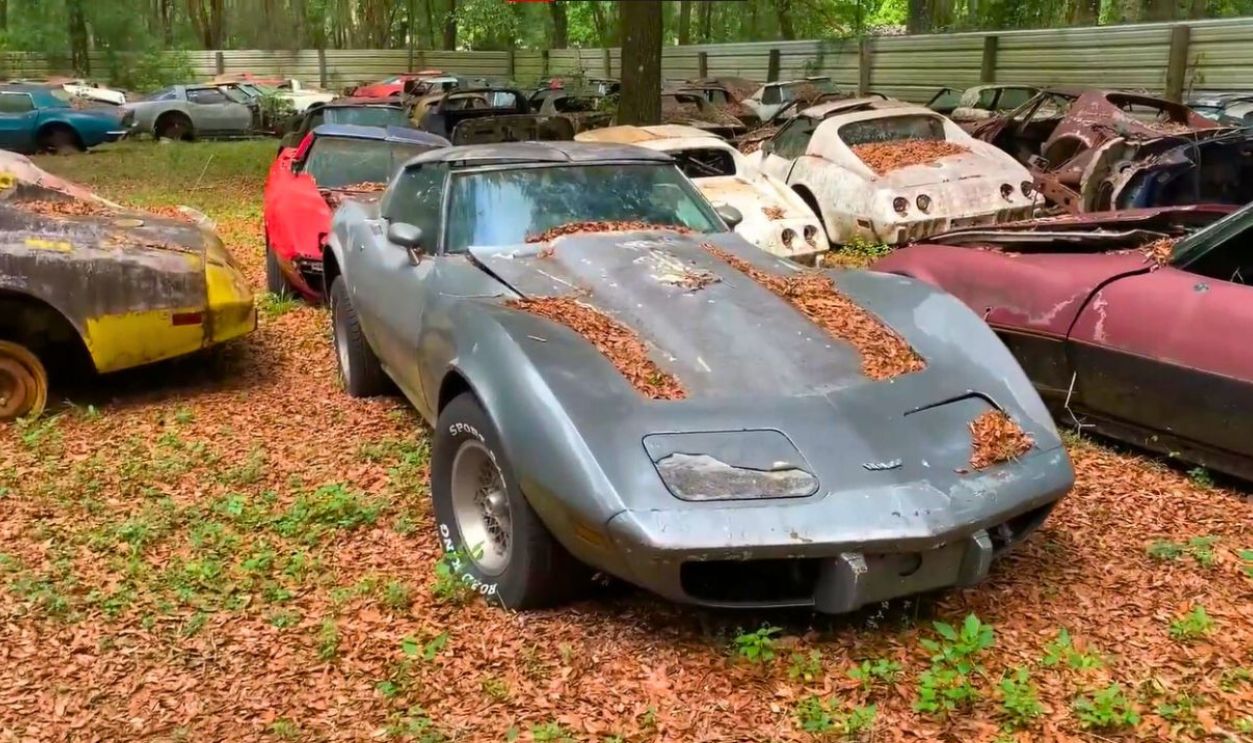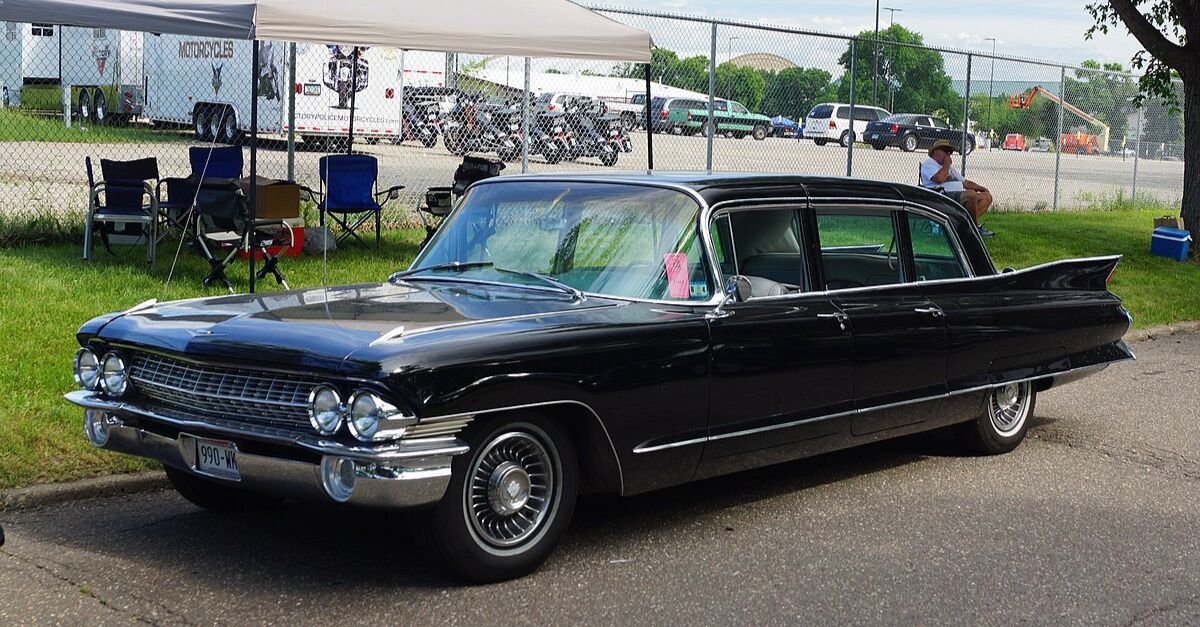Hidden Among Rice Paddies
Imagine exploring vast Japanese rice fields, and then you stumble upon a set of abandoned American cars. How did they get here, and what is the story? Folks, brace yourself; it gets interesting.

Found In The Most Unexpected Locale
YouTuber and racing driver Sammit uncovered a sprawling car graveyard in a massive rice field in Japan. This eerie location is home to classic vehicles, including rare American muscle cars like vintage Corvettes. This discovery is truly heartbreaking because what would warrant this?
 The Ricer Corvette Abandoned in Japan by SAMMIT
The Ricer Corvette Abandoned in Japan by SAMMIT
A Trove Of Classics
Among the crops, forgotten Corvettes (among other vehicles) emerge, their sleek carbon fiber exteriors contrasting sharply against the green rural backdrop. These don’t belong here, but there has to be a story. A story no one had dared share yet.
 The Ricer Corvette Abandoned in Japan by SAMMIT
The Ricer Corvette Abandoned in Japan by SAMMIT
Why Farmland?
These cars rest on land rented by a local rice farmer, an unassuming host to vehicles that once symbolized luxury and speed. Perhaps the irony draws attention—a place of growth and sustenance preserving relics of excess and engineering. Farmland has never been known to harbor such secrets. It’s weird.
 The Ricer Corvette Abandoned in Japan by SAMMIT
The Ricer Corvette Abandoned in Japan by SAMMIT
The Mystery Behind Abandoned Vehicles
The exact reasons why cars end up in graveyards like this remain unknown. It's evident that the residents have seen these metallic relics as they go about their business, but why didn’t they say anything? Now, we are just left to speculate, and here are a few suggestions:
 JAPAN’S NISSAN SKYLINE GRAVEYARD! by SAMMIT
JAPAN’S NISSAN SKYLINE GRAVEYARD! by SAMMIT
Forgotten, Stolen, Seized, Or Abandoned
Some vehicles in this yard may have been forgotten by their owners, others could have been stolen, seized by authorities, or abandoned after the owner's passing. It is also possible that one might have just dumped them there because they did not work as they should. Who knows?
 The Ricer Corvette Abandoned in Japan by SAMMIT
The Ricer Corvette Abandoned in Japan by SAMMIT
Then There’s The Surrounding Metal Scraps
Scraps of metal, stacked fridges, and crushed cans surround these forgotten cars, creating an eerie scene resembling an industrial dumping site. Among this chaos lies undeniable beauty—gleaming Corvettes, their iconic designs still commanding attention despite years of neglect. It’s a sight that begs for stories behind the mess.
 The Ricer Corvette Abandoned in Japan by SAMMIT
The Ricer Corvette Abandoned in Japan by SAMMIT
Too Many Questions
What led to such an eclectic mix of waste and wonder? Theories range from illegal dumping to a failed collector's yard—no clear answers. Yet, one thing’s certain: These cars tell tales of a once-glorious past now in mystery. The one Sammit saw up close was a rare C3 Corvette.
 Kuebi = Armin Kübelbeck, CC BY-SA 3.0, Wikimedia Commons
Kuebi = Armin Kübelbeck, CC BY-SA 3.0, Wikimedia Commons
Just How Rare Is The C3 Corvette?
The C3 Corvette is a classic collector's fight to own. They were produced from 1968 to 1982 and are known for their iconic "shark" design, which featured innovations like T-top roofs and powerful V8 engines. Specific models, like the L88 and ZR1, are exceptionally rare, with limited production numbers.
 Sicnag, CC BY 2.0, Wikimedia Commons
Sicnag, CC BY 2.0, Wikimedia Commons
How About In Japan?
Have you ever seen a unicorn in real life? That’s how rare a C3 Corvette is on Japanese roads. This might be due to strict import regulations and limited demand for American muscle cars during their production era. This is one reason why finding a Corvette here was a shock.
 Sicnag, CC BY 2.0, Wikimedia Commons
Sicnag, CC BY 2.0, Wikimedia Commons
Next To The C3 Was A Gas Mask, Why?
Upon closer inspection, Sammit found a gas mask beside a vintage Corvette. Was it a relic of an industrial accident or a precautionary measure? Perhaps it hints at environmental hazards in the area. With stacks of discarded appliances nearby, the possibility of poisonous waste contamination looms.
 The Ricer Corvette Abandoned in Japan by SAMMIT
The Ricer Corvette Abandoned in Japan by SAMMIT
This Corvette Had Mixed Fluids
Despite its abandoned state, the Corvette nearest Sammit offered clues about its mechanical condition. The transmission fluid remained intact—a small victory—but the water had mixed with the engine oil, spelling disaster for the car's internals. Still, enthusiasts would see potential in this neglected beauty.
 The Ricer Corvette Abandoned in Japan by SAMMIT
The Ricer Corvette Abandoned in Japan by SAMMIT
How Do The Elements Take Over?
As expected, if you leave a car idle, water and other weather elements take over. That’s vegetation, soil, and water. Sometimes, animals turn it into a home. This exposure to the elements likely caused deterioration over time, leading to contamination. If technology is not used, nature takes over.
 The Ricer Corvette Abandoned in Japan by SAMMIT
The Ricer Corvette Abandoned in Japan by SAMMIT
How Water Implicates The Engine’s Operation
Water in engine oil spells doom for any vehicle. It dilutes the oil, reducing its lubrication effectiveness and increasing friction, which leads to wear. Overheating becomes a concern as the oil loses its cooling properties. Corrosion sets in, and white smoke or engine knocking may ensue. Can it run? Nope.
 The Ricer Corvette Abandoned in Japan by SAMMIT
The Ricer Corvette Abandoned in Japan by SAMMIT
Carbon Fiber Exterior
Unlike its internals, the Corvette's carbon fiber exterior seems salvageable. Its smooth, glossy surface remained remarkably resilient against rust and decay. This is one thing the engineers got right because carbon fiber resists corrosion and weathering, unlike steel. For restoration enthusiasts, this detail screams opportunity.
 The Ricer Corvette Abandoned in Japan by SAMMIT
The Ricer Corvette Abandoned in Japan by SAMMIT
No VIN, No Trace
The VINs, manufacturing dates, and other details were deliberately scraped off. It’s as if someone wanted these cars erased from history. But what would be the reason anyone would go to such lengths to anonymize these vehicles? Perhaps it was a collector avoiding taxes or a smuggler covering illegal imports.
 The Ricer Corvette Abandoned in Japan by SAMMIT
The Ricer Corvette Abandoned in Japan by SAMMIT
A Farm-Turned-Car Graveyard
Farmland isn’t where you expect to find luxury cars, but here they sit, juxtaposed against vibrant rice fields. The scene feels like a forgotten movie set—each car a relic of a bygone era. Far from prying eyes, the rural location offers seclusion, ideal for stashing valuable items.
 The Ricer Corvette Abandoned in Japan by SAMMIT
The Ricer Corvette Abandoned in Japan by SAMMIT
Possible Reasons These Cars Remained Idle
Now, here comes rolling in the theories. First, it's possible that Japan's stringent import policies could have blacklisted American vehicles like this Corvette, making ownership a logistical nightmare. This isn’t a new concept because Japan has been known to impose strict regulations on vehicle size, emissions, and safety standards.
 The EASIEST Way to IMPORT a Car from JAPAN to the US! by illiminate
The EASIEST Way to IMPORT a Car from JAPAN to the US! by illiminate
But Why Target American Cars?
Older American supercars, like the C3, especially those from the 1960s and 1970s, are generally not very eco-friendly by today's standards. These cars were built when environmental concerns were not a priority, and they typically feature large, gas-guzzling V8 engines with poor fuel efficiency.
 Greg Gjerdingen from Willmar, USA, CC BY 2.0, Wikimedia Commons
Greg Gjerdingen from Willmar, USA, CC BY 2.0, Wikimedia Commons
More Reasons Were That
Their size and fuel inefficiency clashed with Japan’s compact, eco-friendly market. These policies could have sidelined iconic models and created a challenging market. This is a more substantial reason that would have contributed to their eventual abandonment. There’s another reason:
Perhaps A Car Collecting Plan Gone Wrong
Suppose an aspiring or already established car collector wanted to start a museum but, reality, had more plans. Truthfully, collecting cars as a passion can become a financial burden when unplanned. The abandoned state could suggest an owner who may have been caught in an endless cycle of unfinished projects.
 FULL TOUR Of My COMPLETE CAR COLLECTION! NEW MrJWW Garage by Mr JWW
FULL TOUR Of My COMPLETE CAR COLLECTION! NEW MrJWW Garage by Mr JWW
The Purported Collector’s Woes
What could possibly lead to such a financial downfall? For one, car collectors cave to cover all the high restoration, parts, storage, and upkeep costs. Even the most dedicated enthusiasts are sometimes forced to part with their prized collections when the financial burden becomes too heavy.
 500 CARS in ONE COLLECTION! Visiting American Car Heaven by Shmee150
500 CARS in ONE COLLECTION! Visiting American Car Heaven by Shmee150
Japan Also Prefers Cars They’ve Made
The Japanese have also been adamant about sticking to Asian creations like Toyota, Honda, and Nissan. This might also be why these cars found homes in dumping sites rather than people’s garages. But wait a minute; would this warrant a car being abandoned near rice fields?
 TTTNIS, CC0, Wikimedia Commons
TTTNIS, CC0, Wikimedia Commons
The Rise And Fall Of The American Car In Japan
Japan wasn’t always against American vehicles because, in the 1980s, there was a surge in the popularity of American cars in Japan, driven by a fascination with their raw power and exotic appeal. But this love affair quickly turned sour as Japan’s automotive culture preferred smaller, more efficient vehicles.
 TTTNIS, CC0, Wikimedia Commons
TTTNIS, CC0, Wikimedia Commons
How Did This Change Unfold?
The economy took a hit—rising fuel prices forced people to refocus on compact efficiency. Because of this, American cars like the Corvette became impractical for the Japanese car economy. Despite their initial charm, these vehicles were no longer seen as viable investments in Japan’s dynamic car market.
 Robotriot, CC BY-SA 3.0via Wikimedia Commons
Robotriot, CC BY-SA 3.0via Wikimedia Commons
The Grey Market Phenomenon
Grey market imports were standard in Japan, especially during the 1980s and 1990s, as enthusiasts sought American-made cars. With few official channels for acquiring such vehicles, many turned to underground networks, and this created a thriving but often shady market, creating the grey market.
What Made This Market So Alluring?
The exclusivity of rare American cars like the Corvette was a big draw, but the process often involved avoiding taxes and regulations. So, to prevent governmental scrutiny, the risk sometimes led to vehicles being abandoned when owners realized the burden of ownership.
 Cjp24, CC BY-SA 4.0, Wikimedia Commons
Cjp24, CC BY-SA 4.0, Wikimedia Commons
What Classifies A Car A Grey Import?
When vehicles enter the country without the manufacturer’s permission, it's a grey import. In Japan, grey car imports come in three main ways. The first is when the manufacturer doesn’t offer a model specified for the Japanese market. The second is if…
 We Are Grey Imports by Grey Imports
We Are Grey Imports by Grey Imports
It Gets Into Japan As A Used Car
If you buy a used car in the US from a yard or auction and decide to ship it to Japan and then sell it, it is considered a grey import. This is also one of the purported reasons that these vehicles made it to Japan.
The Third Grey Imports Is If
The car is a classic. Here, a collector based in Japan acquires a vehicle that has been in the market for decades, and now it is time for it to just bask in glory. Since we cannot precisely identify the manufacturing years, we cannot definitely say these rides were classics.
 How to Find Your VIN Number by DamagedCars.com
How to Find Your VIN Number by DamagedCars.com
These Car Graveyards Held More Than Cars
This graveyard isn't just for cars; it also possibly holds a collection of abandoned boats and other vehicles. It was a strange sight from an apocalyptic movie with a mix of forgotten automotive history scattered across a rice field, far from their original home and purpose.
 The Ricer Corvette Abandoned in Japan by SAMMIT
The Ricer Corvette Abandoned in Japan by SAMMIT
What Would Boats Be Doing Next To Cars?
Finding boats alongside cars in a Japanese car graveyard raises questions. These vessels seem out of place, yet their presence suggests a dumping site for unwanted or seized items. Both cars and boats might share a history of abandonment, owner neglect, or legal issues.
 The Ricer Corvette Abandoned in Japan by SAMMIT
The Ricer Corvette Abandoned in Japan by SAMMIT
From Roads To Waterways
The inclusion of water vessels could hint at another broader story. These watercraft, possibly luxury items, may have been thrown away after falling into disrepair or losing their owners' interest. They could have also been a story of someone who couldn’t pay for their licenses, and the government repossessed them.
 The Ricer Corvette Abandoned in Japan by SAMMIT
The Ricer Corvette Abandoned in Japan by SAMMIT
Not The Japanese People’s Cup Of Tea
Japan’s unique automotive culture is heavily influenced by efficiency, design, compactness, and innovation. In contrast, American cars like the Corvette give users bulky engines and heavy frames. Another factor is the show-off features Japanese people aren’t fans of.
 Mark Harkin, CC BY 2.0, Wikimedia Commons
Mark Harkin, CC BY 2.0, Wikimedia Commons
Is The Site Environment Safe?
Abandoned cars decay and become an environmental hazard. The chemicals and fluids leaking from vehicles can contaminate the soil and water, potentially harming local ecosystems like the rice fields nearby. This situation underscores the importance of properly disposing of cars rather than allowing them to rot away in hidden corners.
 The Ricer Corvette Abandoned in Japan by SAMMIT
The Ricer Corvette Abandoned in Japan by SAMMIT
This Discovery Offers A Glimpse Into The Past
If experts come together to decipher all the cars here, they will find tons of data about these cars. They will get insight into the design elements that once made these cars stand out—sleek lines, powerful engines, and technology—that now only echo the era’s boldness.
 JAPAN’S NISSAN SKYLINE GRAVEYARD! by SAMMIT
JAPAN’S NISSAN SKYLINE GRAVEYARD! by SAMMIT
Almost Buried Dreams
Every abandoned car has a story, and these cars are no different. The sheer abandonment of these vehicles—hidden in rice fields and left to decay—speaks to a larger narrative of forgotten dreams, failed projects, and personal disappointment. These once cherished possessions now lie silent.
 The Ricer Corvette Abandoned in Japan by SAMMIT
The Ricer Corvette Abandoned in Japan by SAMMIT
What Will Become of the Collection?
Given their current state, can these cars ever be restored? Or will they simply remain a haunting reminder of what could have been? The answer depends on who stumbles upon them next. Carbon fiber components and the potential to salvage other parts offer hope, but the likelihood of complete restoration is uncertain.
 The Ricer Corvette Abandoned in Japan by SAMMIT
The Ricer Corvette Abandoned in Japan by SAMMIT
A Mystery Never Solved
Who was the owner of these cars? Their story, now intertwined with the abandoned vehicles, is lost to time. Were they a passionate car enthusiast or just someone chasing a dream that proved unattainable? The story of this forgotten collection remains unsolved, leaving enthusiasts to speculate about its true origins.
What Now?
We bet you are also wondering what happens next after the discovery. Well, this discovery could spark interest from collectors and restoration enthusiasts. Rare cars are hotcakes in this world, and those working on restoration projects might take flights to get a hold of any of the cars found on this site.
 The Ricer Corvette Abandoned in Japan by SAMMIT
The Ricer Corvette Abandoned in Japan by SAMMIT
It Could Spark A Global Car Grave Hunt
Our digital world is so interesting that this find could start a trend of hidden car graveyard hunts across Japan and beyond. Urban explorers and content creators will relish uncovering such discoveries and unearth a broader narrative of abandonment and rediscovery.
 UNTOLD FAMILY STORY! 50 years of Japanese Racing History. by juiceboxforyou
UNTOLD FAMILY STORY! 50 years of Japanese Racing History. by juiceboxforyou
The Fate Of The Graveyard
This specific site will most probably face changes as well. Authorities or landowners may remove the vehicles due to legal or environmental concerns, while some may be auctioned or scrapped. Alternatively, the graveyard could become a local curiosity. It could be changed into some sort of “museum”.
 The Ricer Corvette Abandoned in Japan by SAMMIT
The Ricer Corvette Abandoned in Japan by SAMMIT
Can You See It For Yourself?
Sure, you can, but you have to note that visiting the site might be tricky. Since the cars are on rented farmland and possibly privately owned, access could be restricted. Respect for the landowner’s rights and Japan's strict trespassing laws is also a factor.
 The Ricer Corvette Abandoned in Japan by SAMMIT
The Ricer Corvette Abandoned in Japan by SAMMIT
But There Is A Way, Digital Media
If a trip to Japan isn’t an option, platforms like YouTube and Instagram provide an alternative. Enthusiasts like Sammit have started sharing detailed videos, giving you a front-row seat to the discovery. These digital tours highlight the vehicles’ condition and tell the story behind their mysterious resting place.
 The Ricer Corvette Abandoned in Japan by SAMMIT
The Ricer Corvette Abandoned in Japan by SAMMIT
Discover More Hidden Car Treasures In Japan
Japan has a surprising number of abandoned car sites waiting to be explored. There is more to be explored and we are here for it. Imagine stumbling upon a rural lot filled with forgotten Toyota Supras or a warehouse hiding rusting Nissan Skylines. Intriguing, right?












